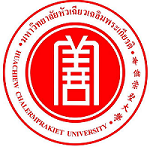Please use this identifier to cite or link to this item:
https://has.hcu.ac.th/jspui/handle/123456789/3768Full metadata record
| DC Field | Value | Language |
|---|---|---|
| dc.contributor.author | จารุณี วังสว่าง | - |
| dc.contributor.author | ชฎาภรณ์ ประสาทกุล | - |
| dc.contributor.author | อาภาภรณ์ บุลสถาพร | - |
| dc.contributor.author | Jarunee Wangsawang | - |
| dc.contributor.author | Chadaporn Prasatkul | - |
| dc.contributor.author | Apaporn Bulsathaporn | - |
| dc.contributor.author | Orawan Koonsanong | - |
| dc.contributor.other | Huachiew Chalermprakiet University. Faculty of Public and Environmental Health. Undergraduate Student | en |
| dc.contributor.other | Huachiew Chalermprakiet University. Faculty of Public and Environmental Health | en |
| dc.contributor.other | Huachiew Chalermprakiet University. Faculty of Public and Environmental Health | en |
| dc.contributor.other | Huachiew Chalermprakiet University. Faculty of Public and Environmental Health | en |
| dc.date.accessioned | 2025-03-25T14:44:01Z | - |
| dc.date.available | 2025-03-25T14:44:01Z | - |
| dc.date.issued | 2017 | - |
| dc.identifier.uri | https://has.hcu.ac.th/jspui/handle/123456789/3768 | - |
| dc.description | งานประชุมวิชาการระดับชาติครั้งที่ 9 มหาวิทยาลัยราชภัฏนครปฐม “พัฒนางานวิจัย สร้างสรรค์อุดมศึกษาไทย ก้าวไกลสู่ Thailand 4.0” มหาวิทยาลัยราชภัฏนครปฐม, จังหวัดนครปฐม, 28 - 29 กันยายน 2560 : 653-660 | en |
| dc.description | สามารถเข้าถึงบทความฉบับเต็ม (Full Text) ได้ที่ : https://dept.npru.ac.th/conference9/data/files/%E0%B9%80%E0%B8%AD%E0%B8%81%E0%B8%AA%E0%B8%B2%E0%B8%A3%E0%B8%9B%E0%B8%A3%E0%B8%B0%E0%B8%81%E0%B8%AD%E0%B8%9A%E0%B8%81%E0%B8%B2%E0%B8%A3%E0%B8%9B%E0%B8%A3%E0%B8%B0%E0%B8%8A%E0%B8%B8%E0%B8%A1%E0%B8%A7%E0%B8%B4%E0%B8%8A%E0%B8%B2%E0%B8%81%E0%B8%B2%E0%B8%A3%E0%B8%A3%E0%B8%B0%E0%B8%94%E0%B8%B1%E0%B8%9A%E0%B8%8A%E0%B8%B2%E0%B8%95%E0%B8%B4%20%E0%B8%84%E0%B8%A3%E0%B8%B1%E0%B9%89%E0%B8%87%E0%B8%97%E0%B8%B5%E0%B9%88%209%20%28Proceeding%20NPRU9%20Full%20Paper%29.pdf | en |
| dc.description | The 9th NPRU National Academic Conference “Achieving Thailand 4.0 through Research Development in Higher Education” Nakhon Pathom Rajabhat University, Nakhon Pathom, Thailand, 28 - 29 September 2017 : 653-660 | en |
| dc.description.abstract | การวิจัยครั้งนี้เป็นการวิจัยเชิงทดลอง เพื่อศึกษาประสิทธิภาพการดูดซับแคดเมียมโดยใช้วัสดุดูดซับทางธรรมชาติที่พบได้มากในท้องถิ่น โดยนํามาผ่านกระบวนการคาร์บอไนซ์เซชั่น ได้แก่ เปลือกหมาก ชานอ้อยและฟางข้าว และเปรียบเทียบประสิทธิภาพ การดูดซับแคดเมียมจากวัสดุธรรมชาติ 3 ชนิด ตามระยะเวลาสัมผัสที่แตกต่างกัน โดยใช้สถิติ Two Way ANOVA วัสดุดูดซับถูกบดร้อนให้มีขนาดเล็กกว่า 2 มิลลิเมตร ในการทดลองใช้วัสดุดูดซับน้ําหนัก 1 กรัม ความเร็วรอบ 120 รอบต่อนาที ระยะเวลาสัมผัสที่ 20, 40 และ 60 นาที และควบคุมอุณหภูมิที่ 25 องศาเซลเซียส จากนั้นนําไปย่อยด้วยวิธีไมโครเวฟ (Microwave Digestion) แล้วนําตัวอย่างไปตรวจวัดปริมาณแคดเมียมด้วยเครื่อง Atomic Absorption Spectrophotometer (AAS) โดยใช้เทคนิค Graphite Furnace Atomic Absorption Spectrometry (GFAAS) พบว่า ที่ระดับความเข้มข้นแคดเมียม 5 มิลลิกรัมต่อลิตร ฟางข้าวมีประสิทธิภาพการดูดซับที่ดีที่สุด ประสิทธิภาพการดูดซับร้อยละ 99.60 ระยะเวลาสัมผัสที่ 60 นาที แต่เมื่อนํามาทดสอบทางสถิติ พบว่าประสิทธิภาพของวัสดุดูดซับทั้ง 3 ชนิด และระยะเวลาสัมผัสที่เพิ่มมากขึ้นไม่มีผลต่อประสิทธิภาพในการดูดซับ แคดเมียมอย่างมีนัยสําคัญทางสถิติ | en |
| dc.description.abstract | This research was an experimental research. The objectives of this research were 1) to study adsorption efficiency of Cadmium using carbonized natural materials from local area including areca palm, bagasse, and rice straw, and 2) to compare adsorption efficiency of Cadmium using three carbonized natural materials at different exposure times. The statistic used Two-Way ANOVA. The adsorbed material was crushed to a size of less than 2 millimeters. In the experiment around 120 rounds per minute, dry natural materials of 1 gram were used at the different exposure times were 20, 40 and 60 minutes, and the temperature was controlled at 25°C and then microwave digested. After that, the samples were measured cadmium by Atomic Absorption Spectrophotometer (AAS) using Graphite Furnace Atomic Absorption Spectrometry (GFAAS). The results were found that the carbonized natural materials from the rice straw were the best adsorption efficiency of Cadmium (99.60%) at concentrations of 5 milligrams per liter and exposure times of 60 minutes. In comparisons, there was no statistically significant different of the adsorption efficiency of Cadmium using three carbonized natural materials at different exposure times. | en |
| dc.language.iso | th | en |
| dc.rights | มหาวิทยาลัยราชภัฏนครปฐม | en |
| dc.subject | แคดเมียม | en |
| dc.subject | Cadmium | en |
| dc.subject | การดูดซับ | en |
| dc.subject | Adsorption | en |
| dc.subject | คาร์บอไนเซชัน | en |
| dc.subject | Carbonization | en |
| dc.subject | หมาก | en |
| dc.subject | Betel nut | en |
| dc.subject | Areca palm | en |
| dc.subject | ชานอ้อย | en |
| dc.subject | Bagasse | en |
| dc.subject | ฟางข้าว | en |
| dc.subject | Rice straw | en |
| dc.subject | เครื่องวิเคราะห์ปริมาณธาตุโดยการดูดกลืนแสงของอะตอม | en |
| dc.subject | Atomic Absorption Spectrophotometer | en |
| dc.subject | Graphite Furnace Atomic Absorption | en |
| dc.subject | กราไฟต์เฟอร์แนสอะตอมมิกแอบซอร์พชัน | en |
| dc.title | ประสิทธิภาพการดูดซับแคดเมียมโดยใช้วัสดุจากธรรมชาติที่ผ่านกระบวนการคาร์บอไนซ์เซชั่น | en |
| dc.title.alternative | Adsorption Efficiency of Cadmium Using Carbonized Natural Materials | en |
| dc.type | Proceeding Document | en |
| Appears in Collections: | Public and Environmental Health - Proceeding Document | |
Files in This Item:
| File | Description | Size | Format | |
|---|---|---|---|---|
| Adsorption-Efficiency-of-Cadmium-Using-Carbonized-Natural-Materials.pdf | 108.98 kB | Adobe PDF | View/Open |
Items in DSpace are protected by copyright, with all rights reserved, unless otherwise indicated.
